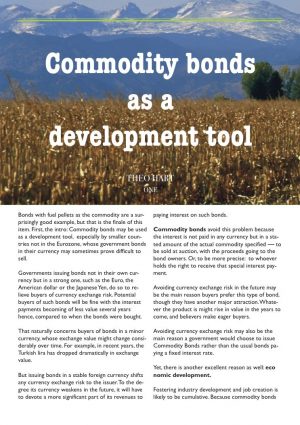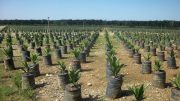 Bonds with fuel pellets as the commodity are a surprisingly good example, but that is the finale of this item. First, the intro: Commodity bonds may be used as a development tool, especially by smaller countries not in the Eurozone, whose government bonds in their currency may sometimes prove difficult to sell.
Bonds with fuel pellets as the commodity are a surprisingly good example, but that is the finale of this item. First, the intro: Commodity bonds may be used as a development tool, especially by smaller countries not in the Eurozone, whose government bonds in their currency may sometimes prove difficult to sell.
Governments issuing bonds not in their own currency but in a strong one, such as the Euro, the American dollar or the Japanese Yen, do so to relieve buyers of currency exchange risk. Potential buyers of such bonds will have no fear of the interest payments becoming of less value several years hence, compared to when the bonds were bought.
That naturally concerns buyers of bonds in a minor currency, whose exchange value might change considerably over time. For example, in recent years, the Turkish lira has dropped dramatically in exchange value.
But issuing bonds in a stable foreign currency shifts any currency exchange risk to the issuer. To the degree its currency weakens in the future, it will have to devote a more significant part of its revenues to paying interest on such bonds.
Commodity bonds avoid this problem because the interest is not paid in any currency but in a stated amount of the actual commodity specified ― to be sold at auction, with the proceeds going to the bond owners. Or, to be more precise: to whoever holds the right to receive that special interest payment.
Avoiding currency exchange risk in the future may be the main reason buyers prefer this type of bond, though they have another major attraction. Whatever the product is might rise in value in the years to come, and believers make eager buyers.
Avoiding currency exchange risk may also be the main reason a government would choose to issue Commodity Bonds rather than the usual bonds paying a fixed interest rate.
Yet, there is another excellent reason as well: economic development.
Fostering industry development and job creation is likely to be cumulative. Because commodity bonds pay in an actual product, the issuing government will be buying that product from local producers, who in turn are purchasing the inputs needed to produce whatever it is—and doing so locally.
Producers with multi-year contracts with the issuing government for a good part of their output should have little difficulty obtaining private financing. Of course, they will want to produce more than the contracts call for. Having a solid output base, anything additional should be at a lower unit cost than otherwise and thus likely profitable even at a lower price. The suppliers they use will likely be the same local ones, further boosting the local economy.
Politicians love to take credit for this sort of thing, as voters generally approve of more employment because it often results in greater consumer spending and more income for a wide array of businesses. Numerous are the voters who then benefit to some extent. Issuing commodity bonds is a good re-election strategy, though some bond commodities would be more significant than others.
Suppose that product is biofuels, and let’s confine it to liquid furnace fuels comparable to what is currently in use. Notice how general the wording can be; it is not stated as one specific fuel only.
Similarly, was this intended for today’s car engines, it would be a mistake to tie the bonds to bioethanol specifically. Instead, bond payments should be in “a biofuel suitable for a gasoline engine”, which provides room for future supply contracts to be in biofuels other than ethanol. The bond term is likely for fifteen or more years, after all, and the current obsession with bioethanol will eventually end.
Liquid furnace fuels now are typically a particular cut of the output from a petroleum refinery, something which might otherwise have been made into diesel fuel. So as liquid furnace fuels become more biofuel than fossil fuel, the petroleum refineries will want to make more diesel fuel instead, but only if they can sell it all profitably.
Though hidden from sight inside the furnace, this is burning fuel with the exhaust going out a chimney. Burning fuel in an external combustion (EC)engine is the same, the exhaust going into the air. EC engines could replace diesel in most places. For example, in railway locomotives.
Hybrid transit buses featuring an EC engine would be cheaper than all-electric buses and require no particular infrastructure. When the burner is functioning correctly, the exhaust is reasonably benign.
Having much cleaner emissions than diesel, the air quality in cities would be much improved as EC engines are used in transit buses and certain other road vehicles. These would be Rankine cycle turbines with some energy storage, electric batteries perhaps. Hybrid cars should all have an EC engine instead of a gasoline engine.
So the biofuels meant for liquid fuel furnaces will have a much-expanded market once EC engines come into use.
Strange as it may be, fuel pellets made of lignin would encourage biofuel production even more so than buying the biofuel itself. However improbable this assertion seems, the logic involved is sound. For example, agricultural residues, such as maize cobs, have three main components, each a polymer: cellulose, xylan and lignin. Based on its dry matter, maize cobs are around 40% cellulose, 33% xylans, and 18% lignin. Other materials say sunflower stems, will differ in these proportions though the order is the same.
Cellulose is comprised of glucose molecules which many microbes utilize, once they can get at them. Glucose molecules are also what starch is made of. But the cellulose is tightly structured and difficult to break up, and the more mature the plant, the more difficult this becomes. In contrast, starch comes apart easily.
Xylan is not a linear polymer but a branched one. It is rather readily removed and broken up. The xylose molecule which comprises it is a five-carbon (C5)sugar, and while many microbes can utilize it, most would rather not, preferring a six-carbon sugar instead, especially glucose. Only when no C6 sugar is present will they begin to use a C5 one.
Lignin is a messy polymer of something indigestible and presently useless, essentially a waste product, often burnt or otherwise disposed of. Imagine being paid for it instead.
Much research has been done on cereal straws to make them into a valuable feed for ruminants, and two things are clear: [one] cattle will lose weight if the straw is the central part of their feed, and [two] removing about half the lignin in straw sees cattle gaining weight slowly when that is the main part of their feed.
Since a ferment within the animals’ rumen is responsible for digestion, an industrial ferment can be done using a somewhat similar mix of microbes on a substrate of farm residues having much of the lignin already removed. Various organic acids result.
These, after some processing, become biofuels of one kind or another, depending largely on the microbes involved and the type of processing. Hydrogenation is one sort, making them into a mix of alcohols.
Couple sale of those biofuels with sale of the removed and pelleted lignin to government buyers, and the revenue situation of the fermenter becomes much more positive.
In this way, issuing commodity bonds where the commodity is lignin fuel pellets can create a biofuel industry based on particular agricultural wastes. And as a bonus benefit ― even a significant benefit, some would say ― those lignin fuel pellets could provide a green fuel to be used in cement kilns.
After all, powdered coal has been used as the primary fuel in such kilns. This is a simple substitution, as would be replacing coal where electricity is still being produced that way.
Theo Hart





